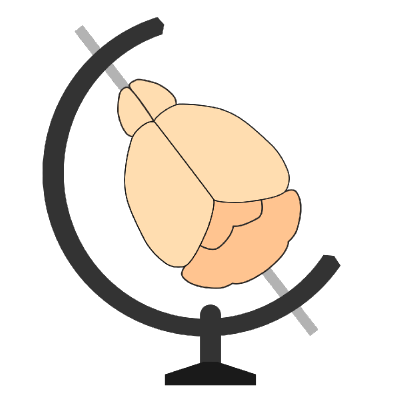Posted in 2024
An atlas for the prairie vole Microtus ochrogaster has been added to BrainGlobe
- 30 October 2024
Prairie voles are a valuable model species for studying social interaction due to their characteristic pair-bonding behavior. The brain of this species is structured similarly to the mouse and is only 30% larger, meaning it is particularly well suited to methods to map brain anatomy and function using light microscopy, such as light-sheet fluorescence microscopy and serial section two-photon microscopy.
An Atlas for the regenerative Ambystoma mexicanum (axolotl) has been added to BrainGlobe
- 09 August 2024
Amphibians have long captivated human’s interest. An unusual amphibian amongst these is the Axolotl (Ambystoma mexicanum), which is sometimes used as a model organism for regeneration. In 2021, Lazcano et al. created a magnetic resonance imaging (MRI) atlas of the juvenile axolotl brain. The axolotl atlas enables researchers to gain better insights into the processes underlying central nervous system (CNS) regeneration.
A mouse brain atlas with barrel field annotations has been added to BrainGlobe
- 02 August 2024
Bolaños-Puchet et al., 2024 recently published annotations of 33 barrels and barrel columns of the mouse isocortex in the Allen Mouse Brain Common Coordinate Framework. The Allen Mouse Brain Atlas (and particularly its Common Coordinate Framework) has been key to advances in computational neuroanatomy in the adult mouse. However, this atlas does not contain detailed annotations of the barrel cortex, which is the dominant topographically represented whisker-related area of the primary somatosensory cortex. The barrel cortex is a highly relevant system to study as mice are nocturnal, tunnel-dwelling animals that largely rely on their whiskers to survive. These annotations allow researchers to much more precisely localise features of interest within specific barrel columns vs. other barrels, within barrels vs. septa, for example, rather than the barrel field as a whole.
New brainmapper napari widget released
- 31 July 2024
One common use of BrainGlobe tools is to analyse the distribution of cells in a whole brain image. This process
involves first detecting cells using cellfinder and then registering (aligning) the
data to a BrainGlobe atlas using brainreg. The detected cell positions must then be
transformed from the coordinate space of the raw data to the coordinate space of the atlas for analysis.
An atlas for the Blind Mexican Cavefish has been added to BrainGlobe
- 21 June 2024
Kozol et al, 2023 recently published a brain atlas of the blind Mexican cavefish Astyanax mexicanus. This species is interesting from an evolutionary point of view, due to divergent phenotypes (surface- and cave-dwelling) that can be hybridised in the lab. Surface-dwelling populations have retained their eyesight, while cave-dwellers have not. The cavefish brain atlas allows us to understand how brains of a single species have changed anatomically and functionally as part of their adaptations to the environment.
Cellfinder version 1.3.0 is released!
- 03 June 2024
We are excited to announce that a new version of cellfinder has been released.
BrainGlobe version 1.1.0 is released!
- 16 May 2024
A new version of the BrainGlobe metapackage has been released following updates to lots of BrainGlobe tools (details below).
bg-atlasapi and bg-atlasgen have merged under a new name
- 14 February 2024
bg-atlasapi and bg-atlasgen have merged into a single package, now called brainglobe-atlasapi.
brainglobe-atlasapi now provides the same API that bg-atlasapi provided, in exactly the same way - all that needs to happen is a name change in your scripts.
imio will be merging into brainglobe-utils
- 08 February 2024
The imio package will be absorbed into brainglobe-utils as a submodule, so will no longer be receiving standalone updates.
This decision was made because:
bg-space has been renamed
- 24 January 2024
The “bg” prefix that a number of BrainGlobe tools carry is not very distinctive nor informative, so we are rolling out minor name changes to a lot of our packages that contain this prefix. We are also taking this opportunity to bring these tools into line with our developer guidelines for automatic deployment, tooling, and testing.
BrainGlobe version 1 is here!
- 08 January 2024
Following our series of incremental updates to a number of BrainGlobe tools, we are pleased to announce that BrainGlobe version 1 has been released today! Users can now enjoy:
cellfinder-core and cellfinder-napari have merged
- 02 January 2024
BrainGlobe version 1 is almost ready, and the next stage of its release journey is the merging of the “backend” cellfinder-core and cellfinder-napari packages into one.
We had previously migrated the cellfinder data analysis workflow into the new brainglobe-workflows package, as part of our efforts to separate “backend” BrainGlobe tools from common analysis pipelines.
This means that there is no longer any need to keep the “backend” package (cellfinder-core) and nor the visualisation plugin (cellfinder-napari) stored in separate, lower-level packages.
As such;
